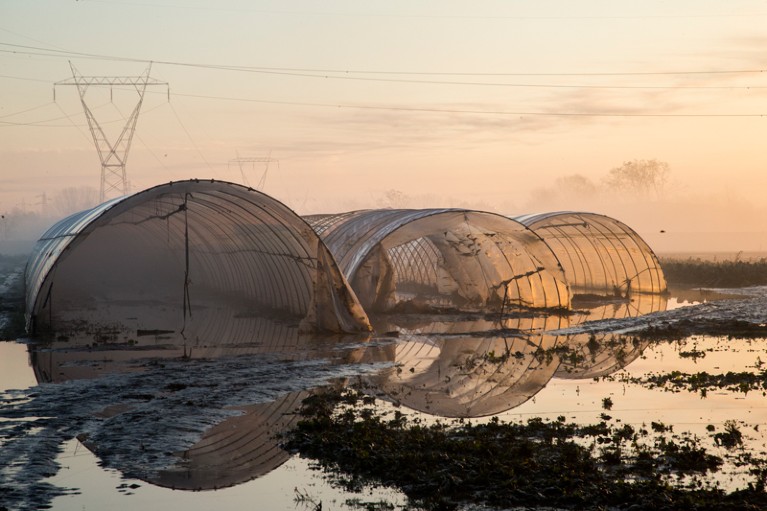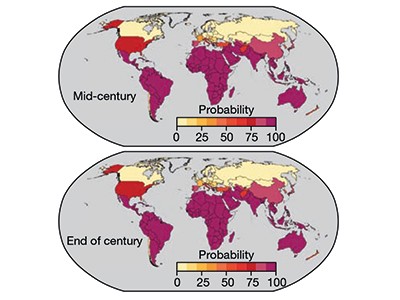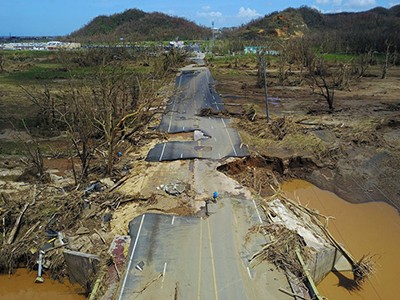
Figure 1 | Flooded farmlands in a village near Turin, Italy.Credit: Mauro Ujetto/NurPhoto/Getty
THE TOPIC IN BRIEF
• Climate change is already affecting the economy through hurricanes, droughts and floods (Fig. 1).
• In a paper in Nature, Burke et al.1 report that achieving global-warming targets set by the United Nations could save trillions of dollars in damages.
• The study’s methodology follows previous literature2,3 by examining the short-term effects of weather on the growth rate of gross domestic product (GDP) — the market value of all goods and services produced in a country in a specific time period.
• These data are then extrapolated into the future to assess the economic impacts of climate change.
• The validity of this approach has been intensely debated in the economics community.
WOLFRAM SCHLENKER: Feeling the heat
Estimates of the economic impacts of climate change are essential for the development of climate policies. Important concerns have been raised about studies such as that of Burke et al., and more research needs to be carried out. However, I think that the authors of these studies are doing the best job possible by basing their estimates on a rigorous analysis and clearly stating their assumptions.
The extrapolation of the historical relationship between temperature and GDP into the future raises the question of whether technological advances might change the predicted trajectory. However, it is worth emphasizing that such extrapolation is based on an econometric model — an economic model based on an empirical analysis — that has been shown to be remarkably consistent between rich and poor countries, as well as between the earlier and later part of the sample period involved (see, for example, ref. 3). This makes it unlikely that adaptation measures are already available, because they have not been deployed in the past even though hot countries would have benefited from them.
Read the paper: Large potential reduction in economic damages under UN mitigation targets
GDP is a useful metric to assess the benefits of limiting global warming. It provides a measurement of human welfare under the assumption that the market prices of goods and services fully reflect the costs of their production and use4. In reality, this assumption is not always valid. For instance, fossil-fuel prices often do not include the costs associated with global warming and other environmental effects on society. However, by focusing only on GDP, huge economic impacts from limiting global warming are predicted. These estimates would be even bigger if the non-market benefits of reduced fossil-fuel use — for example, for human health and ecosystems — were considered.
The predicted impacts are larger than those obtained in earlier work5. The main reason is that strong effects of weather on the growth rate of GDP are found, whereas the earlier work stipulated, but did not empirically test, that weather affects only the level of GDP in a particular year. Heat and drought, for example, directly influence agricultural yields in a given year, but have limited impact in the following years. By contrast, a growth effect implies that a destructive weather event not only decreases GDP in a given year, but also lowers the value for all future years.
The main innovation of studies such as that of Burke and colleagues is to use an econometric model that can incorporate both level and growth effects, without favouring one type of effect over the other2. This is accomplished by including both the current temperature and the temperatures in previous periods in the analysis.
If weather affected GDP only in a given year, immediate impacts would be offset in the future — for example, a 1% decrease in GDP would be offset by a 1% increase in GDP the following year. On the contrary, the authors of these studies find that the impacts are not offset, but rather amplified. The one caveat is that when temperatures in previous periods are included in the analysis, the uncertainties in the projected economic damages increase substantially. Resolving this issue is a key direction for future research.
MAXIMILIAN AUFFHAMMER: Grand damage projections
Translating the impacts of climate change on surface temperature, precipitation and sea level into economic damages is challenging. One approach is to use longitudinal data (repeated measurements of the same variables) to estimate damage functions — mathematical expressions that translate physical impacts into monetary damages6. These functions are associated with specific locations and sectors, such as agriculture or manufacturing. A major drawback is that coverage across locations and sectors is incomplete. Studies such as that of Burke et al. circumvent this problem by using GDP to aggregate economic impacts across sectors. Nevertheless, several issues must be considered before strong conclusions can be drawn from this work.
First, the authors of these studies argue that societal adaptation to climate change is accounted for statistically. However, what is incorporated stems from a historical cross-country comparison of the temperature sensitivity of GDP. In reality, future adaptation will probably involve innovative technologies with lower costs than those that are currently used. Such technologies might include, for example, air conditioners powered by carbon-free electricity that are more energy efficient than present-day devices. Adaptation could therefore result in lower economic damages than are predicted.
Second, on a larger scale, climate change will lead to a planetary redistribution of economic activity, which will result in a redistribution of international trade flows. Such an effect is impossible to quantify credibly and could have a large impact on the projected damages.
Curbing global warming could save US$20 trillion
Third, GDP includes only goods and services that are transacted in markets and therefore have measurable prices. It does not capture the effects of climate change on valuable non-market sectors, such as ecosystem services and biodiversity.
Finally, allowing climate change to influence both the level and the growth rate of GDP is shown to lead to a wide distribution of projected impacts. As a result, neither small (or zero) effects nor massive effects can be ruled out. Attempts to distinguish between these two possibilities using simple statistical models at the global level have been inconclusive.
There are good reasons for thinking that some effects of climate change might be cumulative. For instance, climate and weather will affect the level, and potentially the growth rate and efficiency, of capital and labour. Furthermore, climate might induce technological change through both adaptation and mitigation measures. Pinning down these macroeconomic processes to resolve just how large the effects of climate will be on the long-term growth of GDP needs to be a high priority for future work.

 Read the paper: Large potential reduction in economic damages under UN mitigation targets
Read the paper: Large potential reduction in economic damages under UN mitigation targets
 Curbing global warming could save US$20 trillion
Curbing global warming could save US$20 trillion
 Higher costs of climate change
Higher costs of climate change
 The 'pause' unpacked
The 'pause' unpacked



